Chlamydia – Men Vs Women

Hello and welcome to this presentation. Today, we would like to familiarize you with the necessary knowledge concerning chlamydia, an STI that is common both in men and women. No in this session have we comprehended the symptomology, etiology, treatment, and outright handling of chlamydia, after which the presentation and effects of this disease in both males and females were compared. We will also explore prevention, detection, and management strategies that need to be applied to such cases. Besides, the consideration of the possibility of such infection will be accompanied by how it can be addressed through education to the patient and the partner. By the end of your presentation, you will be enlightened with a lot of knowledge regarding chlamydia infections and be well-equipped to combat this major concern in public health.
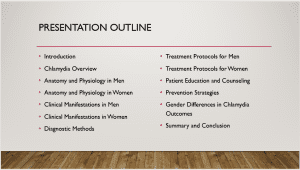
In this presentation on Chlamydia: Men vs. Women, we begin with a brief discussion about the topic, then get familiarized with chlamydia, highlighting why it is significant as a public health issue and why it is crucial to distinguish between genders. We shall look at the structure and functions of organs of reproductive systems that get infected with chlamydia while noting how such aspects affect the development of infection involved. Finally, we will elaborate on clinical manifestations, pointing to the differences between men and women and emphasizing the importance of diagnostics. Diagnostic methods will be discussed further, highlighting the differences in gender and case detection. Finally, treatment algorithms shall be posted and any differences noticed between males and females discussed, as well as special considerations in certain populations. The presentation will also include recommendations regarding the education of the patient and the partner as to how to avoid further infection and passing it to other people, prevention measures, such as personalized measures taking into account the gender of the patient, and a general population campaign. We will further discuss potential complications and long-term outcomes, particularly the gender-specific risks such as infertility. Finally, we will summarize key points and emphasize the need for gender-specific approaches in managing chlamydia, with a look toward future research and public health initiatives.
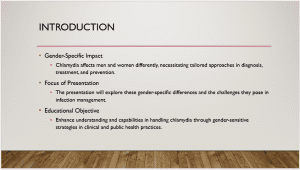
Chlamydia is one of the most common sexually transmitted infections throughout the world, yet it affects men and women differently. Appreciation of these differences is important for diagnosis, treatment, and prevention. This presentation entitled “Chlamydia: Men vs. Women” will enlighten the audience on how each gender uniquely manifests chlamydia, specific challenges regarding infection management, and further call for gender-sensitive approaches in clinical and public health practice. By the end, I will continuously educate you about chlamydia, and further develop your abilities to better handle this pandemic health problem.
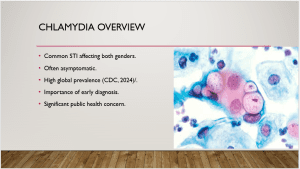
Chlamydia is known globally as one of the most common STIs that can affect a male as well as a female. This is why it is known as the “silent” or ‘asymptomatic’ illness, as it commonly does not show any signs that indicate the presence of the virus. Chlamydia is prevalent globally, with millions of new cases being recorded annually, and therefore is one of the most prevalent STIs (CDC, 2024). In many cases, the infection presents no symptoms; thus, an infected person can transmit the virus unknowingly, which makes screening and early detection crucial. Chlamydia, if not treated, can cause severe health conditions such as infertility, pelvic inflammatory disease in women, and increased chances of developing other STIs such as HIV. Due to the high prevalence of the infection and the potential severe adverse consequences it has on the health of the infected person, the awareness and education that is needed is comparably very high, and so is the need for proper health care.

In males, chlamydia has a predilection for the genitourinary system and affects such structures as the urethra, epididymis, and prostate glands. These then act on the urethra, the tube by which urine is ejected from the body, and give rise to urethritis, evident by discomfort each time the patient urinates. Another important part of the male reproductive system is the epididymis: it is a coiled tube that lies behind the testes and can develop epididymitis. This may cause pain and swelling in the testicles and, if not treated, may lead to long-term difficulties such as pain or inability to produce children. It is rather unusual for the gland responsible for the production of seminal fluid, which is referred to as the prostate, to become inflamed in some way (Mohseni et al., 2023). Chlamydia affects these structures and that is why early diagnosis and treatment should be done to prevent later complications including infertility.
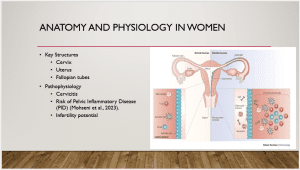
In women, chlamydia predominantly targets the reproductive system with symptoms affecting the cervix, uterus, and fallopian tubes. The lower part of the uterus which is connected with the vagina is primarily affected resulting in inflammation known as cervicitis which may lead to painful discharge and bleeding. If ignored, the infection can spread to the uterus and the fallopian tubes and can lead to Pelvic Inflammatory Disease (PID). PID is a dangerous disease that generates chronic pelvic pain, ectopic pregnancies, and severe injuries to the reproductive apparatus (Mohseni et al., 2023). Tubal blockage and fibrosis resulting from PID are leading causes of female infertility. The possibility of such severe complications underlines the importance of screening for chlamydia regularly, diagnosing it early, and treating the disease in time to minimize the risks of damaging women’s reproductive health and the adverse effects linked to chlamydia.
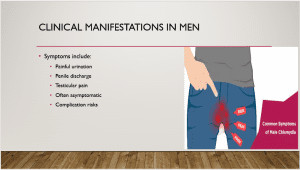
Chlamydia in men may cause various symptoms; however, the majority of infected individuals are asymptomatic and, therefore, spread the disease. The signs and symptoms of the condition include a painful and burning sensation when urinating as well as abnormal discharge from the penis, which may not necessarily be thick or yellow but clear or cloudy. Headache, fever, and nausea may also occur if the infection causes epididymitis, which results in pain or discomfort in the testicles, mainly on one side of the scrotum. However, many of the infected men have minimal or no symptoms, and this means that they can pass the infection to sexual partners without their knowledge. Since chlamydia is often asymptomatic, there are higher chances of complications since the infection could cause complications such as infertility because of the damage done to the reproductive systems. Hence, the recommendation for periodic screening and treatment at the first instance can go a long way in avoiding complications and containing the spread of chlamydia.
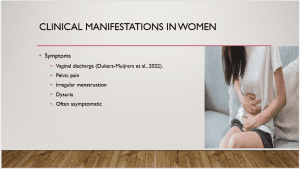
In women, chlamydia can cause several distinctive symptoms, but the majority of women experiencing chlamydial infection do not demonstrate noticeable signs hence delaying treatment. They include; abnormal vaginal discharge, which may be mucous-like or characterized by an unusual smell, and pelvic pain: which is indicative of a deeper infection (Dukers-Muijrers et al., 2022). Abnormal menstrual bleeding, including intermenstrual bleeding or bleeding that is more severe than usual, may be attributed to the effect of the infection on the reproductive organs. Another symptom that may be considered indicative of chlamydial infection is dysuria, which means painful urination. However, similar to many men, most women also have no symptoms at all, which greatly puts them at risk of developing complications like Pelvic Inflammatory Disease (PID). PID can cause Chronic pelvic pain, infertility and ectopic pregnancy due to scarring of tubes. Since chlamydia does not often present symptoms, reliance on testing and early intervention is crucial to avoiding those drastic changes in quality of life.
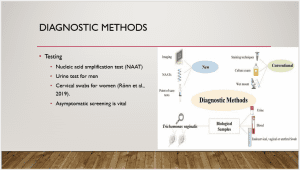
The Nucleic Acid Amplification Test (NAAT) is the best since it has high sensitivity and specificity when diagnosing chlamydia. This test reveals the presence of the DNA of Chlamydia trachomatis, the bacteria that causes the disease. When taken on male subjects, the NAAT can be administered via a urine sample, thereby making it without discomfort. In women, the test may include a cervical swab which is also not very complicated and can be conducted during a normal pelvic examination (Rönn et al., 2019). Since chlamydia does not express symptoms in most cases, especially in women, it is essential to do the screening frequently. Infected individuals with no symptoms may transmit the disease and, in the worst, can lead to complications such as infertility and pelvic inflammatory diseases (PID). Hence, screening at least once per year should be recommended for Chlamydia especially for sexually active individuals or individuals with multiple partners to enable early identification, appropriate management, and reduced transmission of chlamydia within the population.

Standard management for chlamydia in males involves the use of antibiotics, and two such common antibiotics are Azithromycin and Doxycycline (Rodrigues et al., 2022). Azithromycin is generally given in a single dose of 1 gram orally, which is quite comfortable for patients. Doxycycline is given 100 mg twice daily for seven days, and the course should be completed to make sure that the infection is fully gone. Adherence to the prescribed treatment is important, as incomplete treatment can lead to continued infection and contribute to antibiotic resistance. Similarly, treatment of sexual partners is important for the prevention of one’s reinfection and to stop the chain of transmission. Since chlamydia can be asymptomatic, it means that, at times, the partner could have the infection unbeknownst, and this makes partner notification and treatment a key feature of good management. Prevention of complications and subsequent spread of the infection can only be ensured when both the patient and their partners receive and complete the chlamydia treatment regimen.

Treatment of chlamydia in women is the same as in men; it involves a course of antibiotics-either a single dose of Azithromycin-1 gram orally or seven days of Doxycycline-100 mg PO twice daily. However, it requires some special considerations for the safety of both mother and fetus during pregnancy. Azithromycin would normally be preferred in pregnancy because it is considered safe, while Doxycycline is not advisable because this drug poses a risk to the development of the fetus. Indeed, follow-up testing will be important in confirming complete clearance of infection asymptomatic persistence also occurs. This also includes treatment of the partner to prevent reinfection and further spread. Partner treatment thus becomes one of the most important aspects of effective management, as the untreated partners can unknowingly reinfect the patient in a vicious cycle of infection. Comprehensive follow-up and treatment avert serious complications such as Pelvic Inflammatory Disease and infertility.
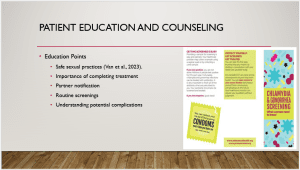
The importance of patient education in chlamydia cannot be overstated since it enables the patient to work towards overcoming the infection and assume responsibility for containing its spread. The patient and other people having sex should change their behavior and learn to protect themselves from minimizing the risks of passing the disease (Van et al., 2023). To elaborate, it is equally crucial to remind the public about the need to finish the entire course of prescribed antibiotics to kill off all of the bacteria and to reduce the chances of the development of antibiotic-resistant bacteria. Patients should be advised to inform and seek treatment for all their recent sexual partners to ensure they do not get reinfected and stop the transmission cycle. Symptomatic screenings are advised, especially for those engaging in sexual activities, to propose treatment in case of having asymptomatic infections. Moreover, some of the consequences that may occur in the case of chlamydia’s lack of treatment, including infertility and PID, can help the patient stick to her treatment and subsequent appointments. Improved education and counseling play central roles in the enhancement of general health and the subsequent decrease in the rates of chlamydia.
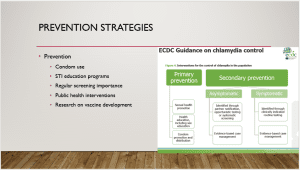
In the prevention of chlamydia, numerous measures involve individual behaviour change, as well as population-based approaches. It has been established that the best way to reduce the spread of chlamydia and other STIs is to engage in consistent and correct condom use. Education programs regarding STIs, safe sex practices, and the necessity of check-ups are crucial, especially for the high-risk audience including young sexually active people. Users are advised to go for a routine check-up frequently, especially for chlamydia as it may not show symptoms. Awareness campaigns, destigmatization efforts, and increased access to testing and treatment are critical features of public health interventions. Also, continuous efforts toward the search for vaccines could offer a long-term method for combating chlamydia and, consequently, decrease the prevalence of the infection globally.
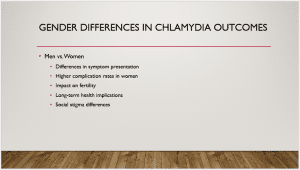
Chlamydia is a bacterial infection that is known to affect both male and female individuals, although the expressions of symptoms and severity of the complications resulting from infection depend on the gender of the affected individual. Females are more affected by chlamydia infection than males since they are likely to suffer from severe complications such as PID, which could cause pelvic pain, and ectopic pregnancy among others that lead to infertility. Men may develop epididymitis, which causes pain and swelling in the testicles and rare cases may result in an inability to have children. Women also tend to have no symptoms or mild symptoms which can lead to late diagnosis and consequently more health complications in the future. Moreover, the cultural and social labels that come with STIs can also differ between the genders where which can influence the way people seek treatment and share their status with their partners. Knowledge of these gender differences is especially important in the treatment and prevention of the disease as well as considering the specifics of the behavior of males and females in the course of the chlamydia infection.
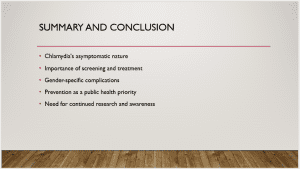
To sum it up, chlamydia is a prevalent STI; it is also predominantly asymptomatic, yet it has severe health consequences in case of poor treatment. Further, regular screening is a must, taking into account the prevalence of asymptomatic infection that, if not appropriately treated, may bring serious complications such as PID in females and infertility. Finally, treatment compliance and notification of sexual partners enable a person to avoid reinfection and further spread of the infection. The infection rate of chlamydia would be reduced further by continuing prevention such as safe sex, education, and screening. Gender disparities in symptoms and complication rates further necessitate targeted interventions. Further research is also needed in the pathophysiology of chlamydia to help elucidate new strategies for intervention, including vaccines, and effective infection control. Raising awareness, availability of tests, and access to treatment are all important elements in managing chlamydia and subsequently reducing its global burden.
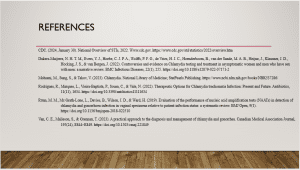
CDC. (2024, January 30). National Overview of STIs, 2022. Www.cdc.gov. https://www.cdc.gov/std/statistics/2022/overview.htm
Dukers-Muijrers, N. H. T. M., Evers, Y. J., Hoebe, C. J. P. A., Wolffs, P. F. G., de Vries, H. J. C., Hoenderboom, B., van der Sande, M. A. B., Heijne, J., Klausner, J. D., Hocking, J. S., & van Bergen, J. (2022). Controversies and evidence on Chlamydia testing and treatment in asymptomatic women and men who have sex with men: a narrative review. BMC Infectious Diseases, 22(1), 255. https://doi.org/10.1186/s12879-022-07171-2
Mohseni, M., Sung, S., & Takov, V. (2023). Chlamydia. National Library of Medicine; StatPearls Publishing. https://www.ncbi.nlm.nih.gov/books/NBK537286/
Rodrigues, R., Marques, L., Vieira-Baptista, P., Sousa, C., & Vale, N. (2022). Therapeutic Options for Chlamydia trachomatis Infection: Present and Future. Antibiotics, 11(11), 1634. https://doi.org/10.3390/antibiotics11111634
Rönn, M. M., Mc Grath-Lone, L., Davies, B., Wilson, J. D., & Ward, H. (2019). Evaluation of the performance of nucleic acid amplification tests (NAATs) in detection of chlamydia and gonorrhoea infection in vaginal specimens relative to patient infection status: a systematic review. BMJ Open, 9(1). https://doi.org/10.1136/bmjopen-2018-022510
Van, C. E., Malleson, S., & Grennan, T. (2023). A practical approach to the diagnosis and management of chlamydia and gonorrhea. Canadian Medical Association Journal, 195(24), E844–E849. https://doi.org/10.1503/cmaj.221849
ORDER A PLAGIARISM-FREE PAPER HERE
We’ll write everything from scratch
Question 
Week 6: Assignment – Chronic Illness PowerPoint Case Presentation
Points: 40 | Due Date: Week 6, Day 7 | CLO: 1, 2, 3, 4, 5, 6 | Grade Category: Assignments
Assignment Prompt
For this assignment you will create an engaging, 20-minute recorded presentation of a chronic health problem related to a particular body system.
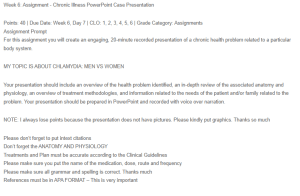
Chlamydia – Men Vs Women
MY TOPIC IS ABOUT CHLAMYDIA: MEN VS WOMEN
Your presentation should include an overview of the health problem identified, an in-depth review of the associated anatomy and physiology, an overview of treatment methodologies, and information related to the needs of the patient and/or family related to the problem. Your presentation should be prepared in PowerPoint and recorded with voice over narration.
NOTE: I always lose points because the presentation does not have pictures. Please kindly put graphics. Thanks so much
Please don’t forget to put intext citations
Don’t forget the ANATOMY AND PHYSIOLOGY
Treatments and Plan must be accurate according to the Clinical Guidelines
Please make sure you put the name of the medication, dose, route and frequency
Please make sure all grammar and spelling is correct. Thanks much
References must be in APA FORMAT – This is very important